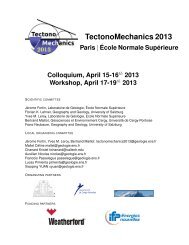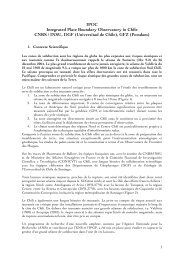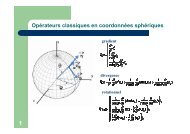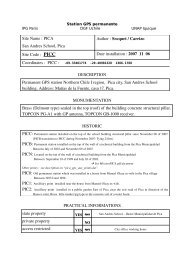PDF file - Laboratoire de Géologie de l'Ecole normale supérieure - Ens
PDF file - Laboratoire de Géologie de l'Ecole normale supérieure - Ens
PDF file - Laboratoire de Géologie de l'Ecole normale supérieure - Ens
You also want an ePaper? Increase the reach of your titles
YUMPU automatically turns print PDFs into web optimized ePapers that Google loves.
9<br />
SOCQUET ET AL.: GPS MEASUREMENTS TO REFINE INDIA/SUNDA RELATIVE MOTION<br />
This second hypothesis implies that <strong>de</strong>formation in<br />
Myanmar is partitioned on two main structures: the<br />
Sagaing Fault and the Arakan trench. Such a partioning<br />
mechanism was <strong>de</strong>scribed a long time ago for the<br />
western Sunda Arc where convergence occur on the<br />
Sunda trench and strike slip on the Great Sumatran<br />
Fault [Curray, 1989; Fitch, 1972]. Here, the<br />
<strong>de</strong>formation would be partially partitioned with 18<br />
mm/yr of pure right-lateral strike-slip on the Sagaing<br />
Fault and still oblique convergence on the Arakan<br />
trench accommodating about 23 mm/yr oriented N 35°<br />
(~18 mm/yr of right-lateral strike-slip and ~13 mm/yr of<br />
convergence).<br />
5.4. Discussion<br />
While earlier seismologic studies suggested<br />
cessation of subduction in Myanmar [Rao and Kumar,<br />
1999], our new data confirm the more recent<br />
interpretations of a still active subduction [Dasgupta, et<br />
al., 2003; Satyabala, 2003; Nielsen, et al., 2004].<br />
However, the localized versus distributed end-members<br />
mo<strong>de</strong>ls remain difficult to discriminate, since structural<br />
and geophysical arguments may support each<br />
hypothesis. Argument against the distribution<br />
hypothesis is that no large straining zone was<br />
recognized west of the main Sagaing fault. [Hla Maung,<br />
1987] postulates transcurrent motion along the Kabaw<br />
Fault, but no geologic nor geophysical evi<strong>de</strong>nce was<br />
reported to indicate such movement [Khin Zaw, 1990].<br />
Moreover, the folds affecting the Myanmar Central<br />
Basins did not accumulate significant shortening since<br />
their formation. [Pivnik, et al., 1998] interpret the enechelon<br />
pattern of the fold axes and reverse faults<br />
affecting the basins as the result of internal shear within<br />
the sliver, as <strong>de</strong>scribed by the mo<strong>de</strong>ls of <strong>de</strong>formation in<br />
fore-arc sliver terranes boun<strong>de</strong>d by an oblique<br />
subduction zone on one si<strong>de</strong> and a trench-parallel strikeslip<br />
fault on the other si<strong>de</strong> [Jarrard, 1986]. [Nielsen, et<br />
al., 2004] proposed partitioning onto the Sagaing fault<br />
and the Arakan trench in southern Myanmar (around<br />
18°N), evolving to full partitioning at higher latitu<strong>de</strong>s<br />
(around 25°N): the shear motion taken on the trench<br />
would be progressively transferred to several strike-slip<br />
and thrust structures within the Arakan wedge. Shallow<br />
seismicity north of 20°N in<strong>de</strong>ed supports current<br />
activity along the strike-slip faults and thrusts affecting<br />
the external part of the Arakan wedge, but seems to be<br />
restricted to the west of station MIND (Fig. 4). If we<br />
acknowledge that no significant motion is<br />
accommodated between this station and the Sagaing<br />
Fault – neither on the Kabaw Fault nor within the<br />
Myanmar Central Basins – then the measured velocity<br />
at MIND station can only be explained by elastic<br />
<strong>de</strong>formation. This pleads for a significant part of the<br />
motion being accommodated on the locked subduction<br />
plane.<br />
This localized two-fault mo<strong>de</strong>l yields a high<br />
seismic hazard on the Arakan trench. If we consi<strong>de</strong>r a<br />
locked plane 400 to 600 km long and 200 km wi<strong>de</strong> –<br />
which corresponds to a plane locked at 50 km <strong>de</strong>pth<br />
with 15° dip – with an accumulation of 23 mm/yr and a<br />
mean crustal shear modulus of 3.3 10 10 Pa, it is due to<br />
produce a magnitu<strong>de</strong> 8.5 earthquake every century or a<br />
magnitu<strong>de</strong> 9 every 500 years [Kanamori, 1977; Wells<br />
and Coppersmith, 1994].<br />
6. Conclusion<br />
Our extensive regional GPS velocity field allows us<br />
to <strong>de</strong>termine both the relative plate motions and the<br />
intra-continental <strong>de</strong>formation in the region of<br />
interaction between India, Eurasia and Sunda plates.<br />
Thanks to long time series, numerous measurements in<br />
Nepal and the availability of ITRF-2000, our new<br />
rotation pole for the Indian Plate yields an<br />
India/Eurasia convergence rate significantly slower (~5<br />
mm/yr) than estimated by previous geo<strong>de</strong>tic<br />
<strong>de</strong>termination [Paul et al., 2001]. Combining with our<br />
refined estimation of Sunda motion, we predict around<br />
36 mm/yr of right-lateral N/S strike-slip and 7 to 9<br />
mm/yr of E-W convergence in Myanmar. Distribution<br />
of active <strong>de</strong>formation in Myanmar is constrained by<br />
far-field plate motion (India / Sunda motion), nearfield<br />
GPS measurements (stations in Myanmar), active<br />
tectonics on land and at sea (faults style and rate) and<br />
seismological data (focal mechanisms). In southern<br />
Myanmar (17°N), the relative India / Sunda motion is<br />
partitioned between the right-lateral Sagaing Fault<br />
slipping at 18 mm/yr and the Andaman trench<br />
accommodating 20 mm/yr of oblique convergence<br />
oriented N30°. A similar two-faults partitioning<br />
process probably prevails in central Myanmar (22°N),<br />
the shear component west of MIND (about 23 mm/yr)<br />
being mainly accommodated as oblique convergence<br />
(oriented N35°) along the Arakan trench. A significant<br />
portion of the Arakan trench is thus presently<br />
elastically locked and accumulating significant motion.<br />
Moreover, this trench portion is localized in a major<br />
seismic gap: to the north, two Mw 8.7 earthquakes<br />
occurred in 1897 in the Shillong Plateau and in 1950 in<br />
Assam, when to the south, the rupture of the Mw 9.2<br />
earthquake of December 2004 exten<strong>de</strong>d up to the<br />
Andaman Islands but not beyond. This has important<br />
implications for seismic hazards along the Burma<br />
subduction front. The 26 December 2004 earthquake<br />
on the Sumatran trench showed that the northern part<br />
of the subduction (Andaman trench) was locked and<br />
had accumulated enough elastic <strong>de</strong>formation to<br />
produce a Mw 8.9 earthquake by itself [Vigny, et al.,<br />
2005]. Our partitioned elastic mo<strong>de</strong>l with oblique slip<br />
on the trench is a simple continuation of this system to<br />
the North and yields high probability for one great






